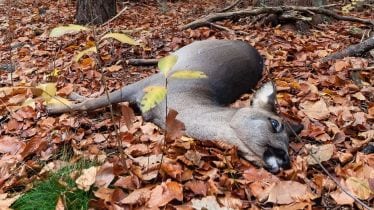The claws of ‘Zombie Deer Disease’ are slowly engulfing American grasslands as the cases of this bizarre disease continue to rise among deer. The spike in cases has become a cause of concern among scientists and they are worried that the disease may evolve to infect humans.
Chronic Wasting Disease (CWD), as it is otherwise known, is a contagious neurological condition that can kill virtually every animal it infects and is spreading rapidly in deer populations across the United States.
According to a report by The Guardian, the Canadian province of British Columbia has released a strategy to combat the spread of chronic wasting disease (CWD) as it continues to move across North America.
The officials of the province ordered the testing of any road-killed deer, moose, elk and caribou after two cases were confirmed last month. According to The Guardian report, both cases – in a mule deer and a white-tailed deer – were found in the Kootenay district. Reportedly, the province also placed restrictions on the movement and disposal of deer in the area.
Currently, the experts are divided over whether CWD could leap to humans, as bovine spongiform encephalopathy or mad cow disease did nearly four decades ago.
“There is no direct evidence that the disease can be transmitted to humans and there have been no cases of the disease in humans,” the province said in its bulletin as quoted by The Guardian.
However, Hermann Schätzl, the associate dean of research at the University of Calgary’s veterinary school, said previous research on macaques suggests transmission of CWD between primates is possible. To understand the possible link, researchers fed the primates infected brain tissue to mimic the long-term consumption of CWD-infected venison in humans.
“In our experimental models, it’s very likely that CWD can infect humans. Has it ever happened before? There is no positive evidence where you can say a human had this prion disease from the consumption of venison. But will it happen in the future? Very likely, yes,” he told the Guardian.
According to Schätzl, the rapid spread of the disease across North America and Scandinavia and the likelihood of it becoming more variable over time “should raise concerns.”
“If chronic wasting disease goes into humans, can it go from human being to human being? That’s the worst case scenario: that you have transmission, a little bit like avian influenza [transmitting between] humans or like Covid making the leap to humans.”
He told The Guardian research into macaques deliberately infected with CWD found more indicators of the disease in the spinal cord than in the central nervous system.
“The thing is, nobody really looks there. And so that’s a question: if we were looking for it in the typical places, would we see it? I don’t think so. I suspect it would look more like an atypical disease.”
Schätzl says the long incubation period of prion diseases means that if a human were infected now, “you would see nothing, probably, and it would take many, many years to show up – and that’s a problem”.
What is ‘Zombie Deer Disease’?
Chronic Wasting Disease (CWD), often dubbed as ‘Zombie Deer Disease’ is caused by misfolded proteins known as prions and affects species in the cervid family.
According to the Centers of Disease Control and Prevention (CDC) the fatal disease affects deer, elk, reindeer, sika deer and moose. It has been found in some areas of North America, including Canada and the United States, Norway and South Korea.
The US-based public health body maintains that it may take over a year before an infected animal develops symptoms, which can include drastic weight loss (wasting), stumbling, listlessness and other neurologic symptoms. CWD can affect animals of all ages and some infected animals may die without ever developing the disease. CWD is fatal to animals and there are no treatments or vaccines.
The lethal disease affects host’s brain and nervous system, leaving deer drooling, stumbling, lethargic and with a blank stare, leading some to call it “zombie deer disease”.
Can ‘Zombie Deer Disease’ infect humans?
There have been no reported cases of CWD infection in humans till now. However, some animal studies suggest CWD poses a risk to certain types of non-human primates, like monkeys, that eat meat from CWD-infected animals or come in contact with brain or body fluids from infected deer or elk. These studies raise concerns that there may also be a risk to people.
According to a report by Daily Mail, recent studies have shown that the prions can infect and multiply in human cells in lab conditions – which has raised the prospect of a spillover. It is thought that humans may contract the disease from eating infected venison, or via contact with contaminated soil and water.
Since 1997, the World Health Organization (WHO) has recommended that it is important to keep the agents of all known prion diseases from entering the human food chain.
Other prion diseases include mad cow disease, has killed over 200 humans, according to the FDA. Mad cow disease infected humans through people eating contaminated beef.
What are the symptoms of ‘Zombie Deer Disease’?
USGS maintains that chronic wasting disease (CWD) has an extended incubation period averaging 18–24 months between infection and the onset of noticeable signs. During this time frame animals look and act normal.
The most obvious sign of CWD is progressive weight loss.
“Numerous behavioral changes also have been reported, including decreased social interaction, loss of awareness, and loss of fear of humans. Diseased animals also may exhibit increased drinking, urination, and excessive salivation. All CWD symptoms can have other causes and could lead to misdiagnosis of the condition if the animal is not specifically tested for CWD,” it stated.
How to prevent ‘Zombie Deer Disease’?
The CDC maintains that if CWD could spread to people, it would most likely be through eating of infected deer and elk. One should refrain from eating eat meat from deer and elk harvested from areas with CWD.
